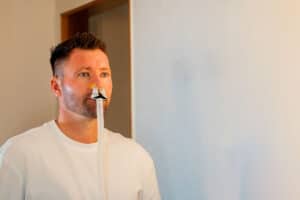
For many people living with sleep apnea, CPAP masks are life-changing. They help maintain open airways, improve oxygen flow, and restore quality sleep. But while CPAP therapy is essential, some users experience unwanted side effects—like skin breakdown, redness, or rashes caused by their masks.
If you’ve noticed irritation on your cheeks, nose, or around your mouth after wearing a full face CPAP mask or nasal mask, you’re not alone. This article explores why skin problems occur, how to prevent them, and what solutions actually work.
Why CPAP Masks Can Irritate Skin
The skin around your nose and face is sensitive, and wearing a CPAP mask for 6–8 hours each night can create problems, such as:
- Pressure sores or skin breakdown from tight mask straps
- Friction and rubbing where the mask cushion touches the face
- Moisture build-up that encourages rashes or acne
- Allergic reactions to silicone or mask materials
These issues are common across all mask styles, including full face CPAP masks, nasal masks, and nasal pillows.
Common Signs of CPAP-Related Skin Issues
If your mask is causing irritation, you may notice:
- Redness or marks on the bridge of the nose
- Itchy or painful rashes on cheeks or chin
- Small sores where the mask cushion rests
- Dry, flaky, or cracked skin under the mask
Over time, these problems can make CPAP therapy uncomfortable, causing some users to remove their mask at night—and lose the benefits of treatment.
How to Prevent Skin Breakdown and Rashes from CPAP Masks
The good news: most skin issues can be managed with a few simple adjustments.
- Choose the right mask size – A poor fit often causes leaks and pressure points. Work with your provider to ensure proper sizing.
- Consider a full face CPAP mask – If nasal masks create pressure on your nose bridge, a full face option may reduce irritation.
- Use CPAP mask liners or pads – Soft fabric liners create a barrier between your skin and the silicone cushion, reducing friction.
- Clean your mask daily – Oils, sweat, and bacteria can build up and worsen irritation. Use mild, fragrance-free cleaners.
- Replace cushions and headgear regularly – Old, worn-out parts don’t seal properly and cause rubbing.
- Moisturize your skin before bed – Use a gentle, non-greasy moisturizer to protect sensitive skin.
- Adjust strap tension – Straps should be snug, not overly tight. Over-tightening increases pressure sores.
When to Seek Medical Advice
If irritation continues despite adjustments, consult your sleep specialist or dermatologist. In some cases, they may recommend:
- Hypoallergenic mask materials
- Prescription creams for rashes or dermatitis
- Alternative mask styles better suited for your skin type
Final Thoughts
While CPAP masks are vital for managing sleep apnea, they can sometimes cause skin breakdown, redness, or rashes. The key is finding the right mask fit, keeping your equipment clean, and protecting your skin with simple care routines.
With the right approach, you don’t have to choose between comfort and effective therapy—you can enjoy both restorative sleep and healthy skin.
